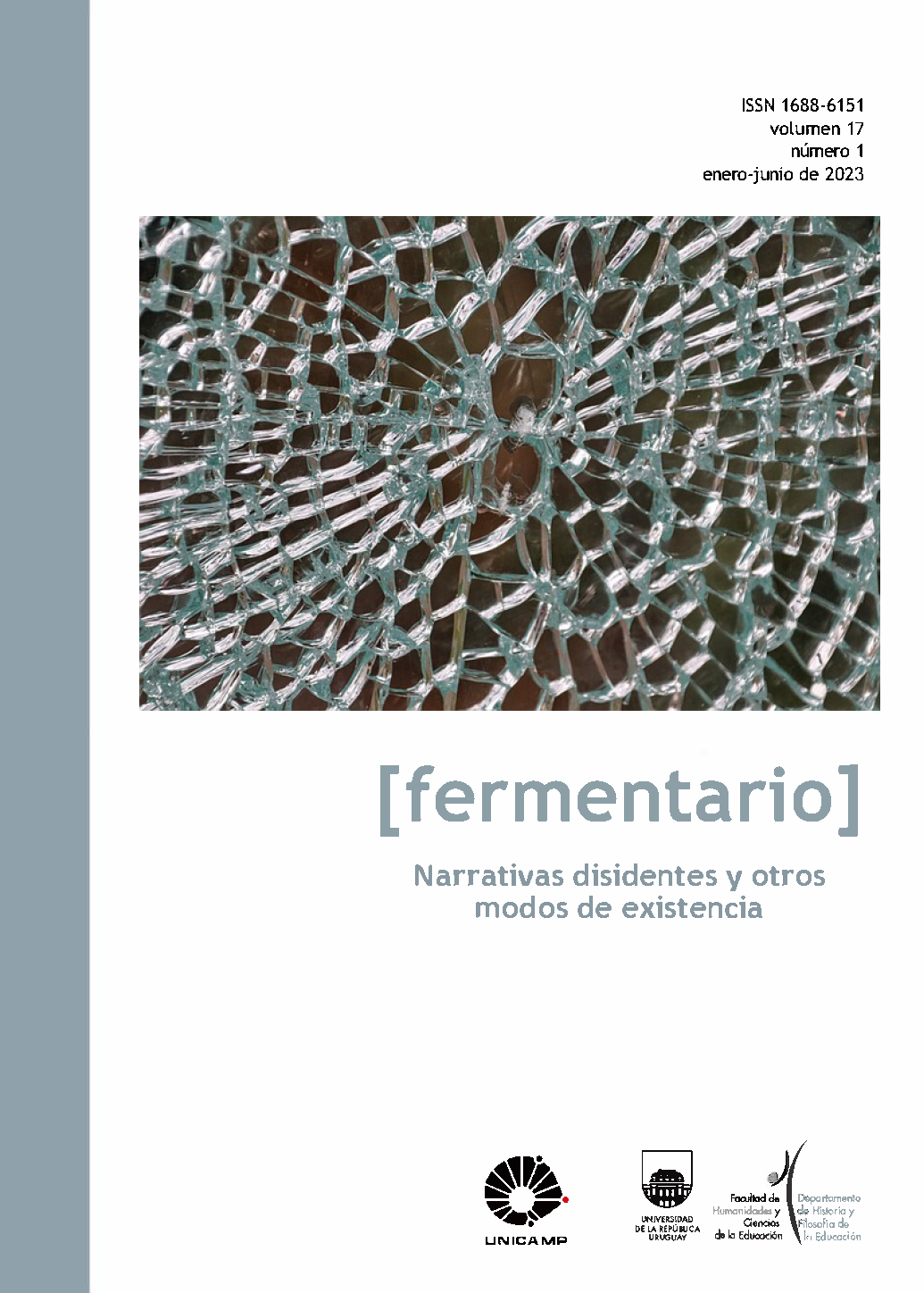Publicado 2023-06-30
Palabras clave
- esfera pública,
- Oskar Negt y Alexander Kluge,
- Nancy Fraser,
- movimientos sociales,
- pluralismo
- narrativas desidentes ...Más
- public sphere,
- Oskar Negt and Alexander Kluge,
- Nancy Fraser,
- social movements,
- pluralism
- dissident narratives ...Más
- esfera pública,
- Oskar Negt e Alexander Kluge,
- Nancy Fraser,
- movimentos sociais,
- pluralismo
- narrativas dissidentes ...Más
Cómo citar
Resumen
En este artículo se argumenta que la noción de la ‘esfera pública’ es crucial para entender las posibilidades de democratización que surgen desde las intervenciones de movimientos sociales actuales en América Latina. En particular, se propone que el modelo mas adecuado en este respecto es el de las ‘contra-esferas públicas.’ Este, se argumenta, es superior al modelo hegemónico ‘burgués,’ y a las alternativas ‘plebeya’ y ‘proletaria,’ pues es el que mejor permite analizar las contribuciones y el potencial transformador de estos movimientos. Para esto, primero se muestran los puntos débiles de los modelos alternativos. Después se argumenta que el modelo burgués de la esfera pública desarrollado por Habermas 1) no logra captar el pluralismo y el multiculturalismo—característicos de las sociedades Latinoamericanas contemporáneas; y 2) no permite entender el valor de fenómenos como el consumo y discusión de objetos culturales, el uso narrativo/poético del lenguaje, o las expresiones estéticas. Esto es problemático, pues son fenómenos constitutivos del contexto Latinoamericano y forman parte fundamental en la construcción y expresión de diversos grupos sociales contra-hegemónicos en la región. Finalmente, apoyándome en los trabajos de Negt y Kluge, Fraser, y en algunas contribuciones feministas, se muestra que el modelo de las contra-esfera públicas es una alternativa superior para aprehender las características de ese espacio publico. En primera instancia, porque se basa en una idea más comprehensiva del ‘universalismo,’ sensible a las diferencias sociales y culturales. En segundo lugar, porque contra el sesgo argumentativo del modelo habermasiano, el de las contra-esferas públicas permite entender el aporte racional y democrático de formas alternativas de expresión, representación, e interacción social.
Descargas
Citas
- Primer encuentro intercontinental por la humanidad y contra el neoliberalism. (1996). Discurso inaugural de la mayor Ana María. Chiapas, núm. 3, México: IIEc, UNAM-Ediciones ERA, 101-105.
- Baeza, C. S. (2018). Burguesa, Plebeya, Proletaria, Alternativa, Subalterna. Conceptualizaciones Histórico-Analíticas Sobre la Noción de la Esfera Pública y su Contribución a los Debates Actuales Sobre la Opinión Pública. En Cotte, S. (Ed.) Opinión Pública Contemporánea. Otras Posibilidades de Comprensión e Investigación. Chile: Social-Ediciones.
- Beberley, J. (1989). The Margin at the Center: On Testimonial Narrative. MFS Modern Fiction Studies, 35 (1), 11-28. DOI: 10.1353/mfs.0.0923.
- Bizberg, I. (2015). Los nuevos movimientos sociales en México: El movimiento por la Paz con Justicia y #Yosoy132. Foro Internacional 219, LV, (1), 262-301. http://www.scielo.org.mx/scielo.php?script=sci_arttext&pid=S0185-013X2015000100262&lng=es&nrm=iso.
- Buchler, S.M. (2013). New social movements and new social movement theory. En D. A. Snow, et. al. (Ed.) The Wiley-Blackwell Encyclopedia of Social and Political Movements, New Jersey: Blackwell.
- Calhoun, C. (1996). Introduction: Habermas and the Public Sphere. En C Calhoun (Ed.), Habermas and the Public Sphere. (pp. 1-48). Cambridge: MIT Press.
- Cohen, J. L. (1982). Between Crisis Management and Social Movements: The Place of Institutional Reform. Telos, vol. 1982 (52), 21-40. DOI: 10.3817/0682052021.
- Downey, J. y Fenton, N. (2003). New Media, Counter Publicity and the Public Sphere. New Media Society, 5, 185-202. http://nms.sagepub.com/content/5/2/185.
- Dowing, J. (2001). Radical Media: Rebellious Communication and Social Movements. California: Sage.
- Eley, G. (1996) Nations, Publics, and Political Cultures: Placing Habermas in the Nineteenth Century. En C Calhoun (Ed.), Habermas and the Public Sphere. (pp. 289-339). Cambridge: MIT Press.
- Felski, R. (1989). Beyond Feminist Aesthetics: Feminist Literature and Social Change. Cambridge: Harvard University Press.
- Fraser, N. (1999). Repensando la esfera pública: Una contribución a la critica de la democracia actualmente existente. Ecuador Debate, 46, 139-173.
- Habermas, J. (1974). The Public Sphere: An Encyclopedia Article. New German Critique, 3, 49-55. http://www.jstor.org/stable/487737.
- Habermas, J. (2009). Historia y crítica de la opinión pública. La transformación estructural de la vida pública. Barcelona: Gustavo Gili.
- Hohendahal, P. U. (1982). The Institution of Criticism. Ithaca: Cornell University Press.
- Koivisto, J. y Valiverronen, E. (1996). The Resurgence of the Critical Theories of Public Sphere. Journal of Communication Inquiry, 20 (2), 18-36.
- Lara, M. P. (1998). Moral Textures. Feminist Narratives in the Public Sphere. Cambridge: Polity Press.
- Lottes, G. (1979). Politische Aufklärung und plebejisches Publikum. Zur Theorie und Praxis des englischen Radikalismus im späten 18. Jahrhundert. Munich; Viena: Oldenbourg.
- Martín Barbero, J. (1991) De los medios a las mediaciones. Comunicación, cultura, y hegemonía. México: Gustavo Gili.
- Negt, O. y Kluge, A. (1993). Public Sphere and Experience: Toward an Analysis of the Bourgeois and Proletarian Public Sphere. Minneapolis: University of Minnesota Press.
- Olsen, T. (2004). Globalizing the Zapatistas: From Third World Solidarity to Global Solidarity? Third World Quarterly, 25, 254-269. https://www.jstor.org/stable/3993787.
- Piccato, P. (2010). Public sphere in Latin America: a map of the historiography. Social History, 35 (2), 165-192. DOI: 10.1080/03071021003795055
- Trigo, A. (2006). De la transculturación (a/en) lo trasnacional. En M. Moraña (Ed.), Ángel Rama y los estudios latinoamericanos. Pittsburgh: Serie Críticas.
- Tunali, T. (2020). Zapatista Voice, Visibility and Vision: An.Other Aesthetics of Neoliberal Globalization. Revista de Estudios Globales y Arte Contemporáneo, 7 (1), 343-378. https://doi.org/10.1344/%25x.
- Young, I. M. (2002). Inclusion and Democracy. Oxford: Oxford University Press.


